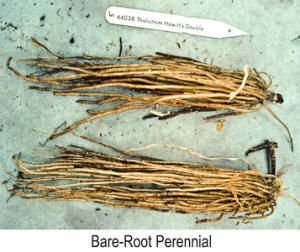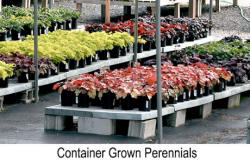Even though they do not form woody
stems, proper planting depth is still important when dealing
with herbaceous perennials. Unlike trees, perennials have a
somewhat limited root zone. Therefore, you will generally be
amending the soil with additional organic matter or other
amendments to make it better for plant growth.
A. Planting Bare Root Herbaceous Perennials - Often, plants sent through the mail or
UPS will come bare root. This is perfectly fine as long as
 you keep them in a cool location or in the refrigerator if
there will be a delay in planting them. Unlike shrubs and
trees, perennials are commonly sent bare root with their
foliage either intact or it may be cut off. By keeping them
cool and moist, they should be o.k.
you keep them in a cool location or in the refrigerator if
there will be a delay in planting them. Unlike shrubs and
trees, perennials are commonly sent bare root with their
foliage either intact or it may be cut off. By keeping them
cool and moist, they should be o.k.
In the garden, simply dig a hole large enough for the depth
and spread of the root mass. Spread the roots out a bit and
fill the hole with the previously amended soil you took out.
Be sure to water them in as soon as possible to eliminate
air pockets in the soil which may dry out the roots.
B. Planting Container Grown Herbaceous Perennials - Herbaceous perennials that come in
plastic containers from the nursery may be treated like any
other container grown plant. Remove the container and check the root mass. If
it is a solid mat of roots or some roots are circling, be
sure to cut them with a knife or pruners. This will help the
plant to spread its roots out into the soil in a more
natural configuration.
 Dig a hole the same depth as the container, spread the
untangled or cut roots out as you place them in the hole and
then cover them with soil. Water the area thoroughly after
planting to help the soil settle and remove any air pockets.
Dig a hole the same depth as the container, spread the
untangled or cut roots out as you place them in the hole and
then cover them with soil. Water the area thoroughly after
planting to help the soil settle and remove any air pockets.
Be sure to follow the spacing guidelines on the container
label. This will allow the plants to grow to their mature
size without crowding others nearby.
We are talking here about that huge category of plants that
are commonly called "bedding plants" in the nursery
industry. In a botanical sense, some of these are true
annuals that complete their life cycle in one year and then
die. However, a big percentage of the plants are really what
are called tender perennials. That is, in their native
environment of the tropics or sub-tropics, these plants
would live more than two years. But, they cannot survive in
areas with cold winter temperatures so they are treated as
"annuals" since they will die when exposed to frosts.
Anyway, planting annuals is just like planting container
grown perennials. Remove the container and check the root
mass. If it is a solid mat of roots or some are circling, be
sure to cut them with a knife or pruners. This will help the
plant to spread its roots out into a more natural
configuration. Dig a hole the same depth as the height of
the container, spread the roots out as you place them in the
hole and the cover them with soil. Water the area to help
the soil settle and remove any air pockets.
Be sure to follow the spacing guidelines on the plant label.
This will allow the plants to expand and fill a certain area
to allow for the bed or border to fill in over the summer
season.
The exception to the spacing rule will apply when you are
putting annuals or perennials in containers. There, you will
generally want to crowd them in so that the pots overflow
and give a great display quickly.
C. Planting Herbaceous Perennials from Seed -
Certainly perennials may be planted from seed but there are
a couple of extra factors to consider over planting annuals.
These would include:
-
Seed Treatments - Annuals are almost all designed
to germinate once the soil gets to a certain
temperature. Many perennials have developed some
different mechanisms to help assure their survival in a
wide range of often unfriendly environments. These fall
into two basic categories: a)
Scarification for hard seeds and b)
Stratification which is a cold, moist treatment.
-
Hybrid Plants - We usually get our annual seeds
in a packet from the plant breeders and are assured that
what we plant will be what we anticipate. However, if
you save seeds from perennials in your garden, the
outcome is not so certain. Many of the plants that are
named cultivars may not come true to seed in the next
generation. These plants are sometimes the results of
specific cross breeding programs and the seeds you
collect are probably crossed with some different
cultivars growing nearby. The plants resulting from such
seeds will often not resemble those from which the seeds
were harvested.
Some perennials, however, reproduce quite nicely from
seed and the seedlings will be just like the mother
plants. The key is for you, as the gardener, to do some
research into the specific type of perennials you want
to start from seed. Find out which ones come true from
seed and which ones do not.



